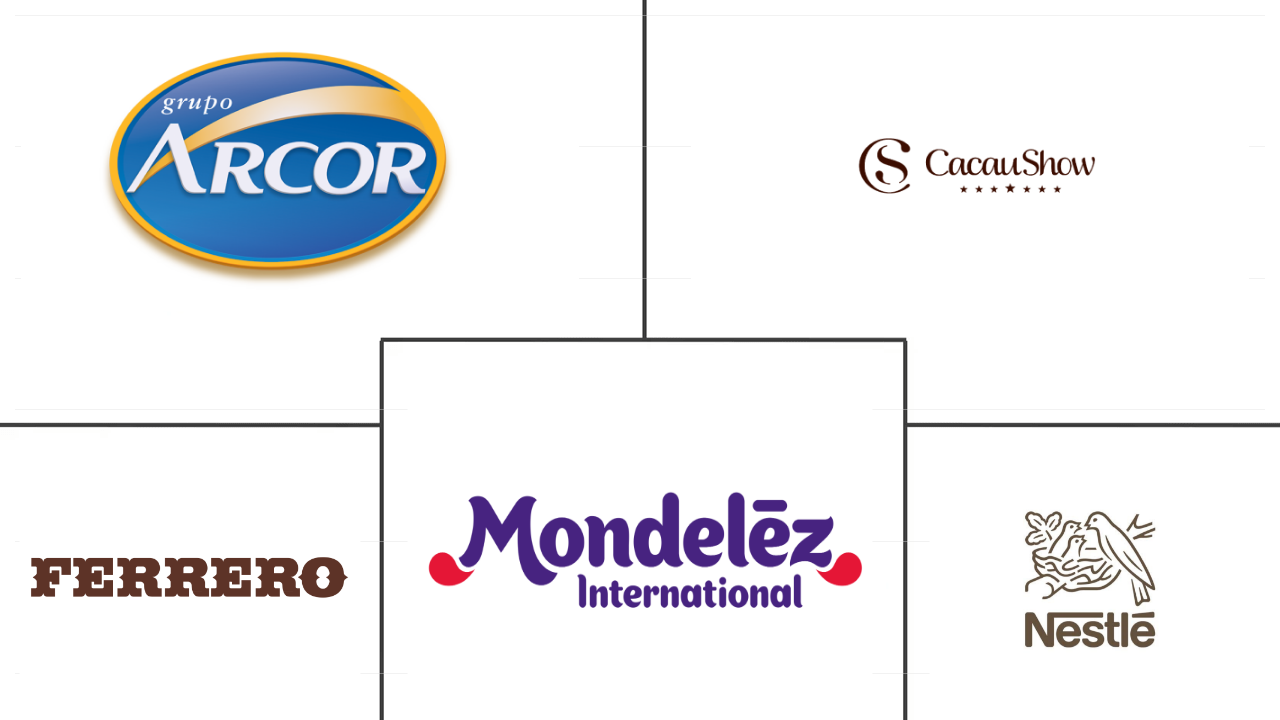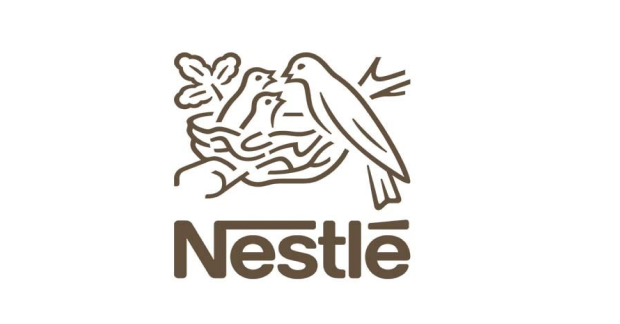Market Size of south america chocolate Industry
|
|
Study Period | 2018 - 2030 |
|
|
Market Size (2024) | USD 5.95 Billion |
|
|
Market Size (2030) | USD 7.68 Billion |
|
|
Largest Share by Distribution Channel | Supermarket/Hypermarket |
|
|
CAGR (2024 - 2030) | 4.34 % |
|
|
Largest Share by Country | Brazil |
Major Players |
||

|
||
|
*Disclaimer: Major Players sorted in no particular order |
South America Chocolate Market Analysis
The South America Chocolate Market size is estimated at 5.95 billion USD in 2024, and is expected to reach 7.68 billion USD by 2030, growing at a CAGR of 4.34% during the forecast period (2024-2030).
5.95 Billion
Market Size in 2024 (USD)
7.68 Billion
Market Size in 2030 (USD)
1.19 %
CAGR (2018-2023)
4.34 %
CAGR (2024-2030)
Largest Segment by Confectionery Variant
64.65 %
value share, Milk and White Chocolate, 2023
The innovative flavor offerings possible in white chocolate, followed by the preference for varied taste profiles in the region, are anticipated to drive segmental growth.
Largest Segment by Country
67.94 %
value share, Brazil, 2023
Advancements in the cocoa chain with increasing cocoa growers in Brazil impacted the chocolate availability in the market, enticing the segmental growth in the study period.
Fastest-growing Segment by Confectionery variant
5.03 %
Projected CAGR, Dark Chocolate, 2024-2030
Rising awareness among consumers toward the nutritional content and stress-relieving ability of dark chocolate is anticipated to drive the demand in the country.
Fastest-growing Segment by Country
5.91 %
Projected CAGR, Argentina, 2024-2030
Adoption of many innovative products, along with rising preference for on-the-go consumption in Argentina, has made it a larger country in the market during the study period.
Leading Market Player
35.27 %
market share, Nestlé SA, 2022

The active market activities, such as product innovations and strategic moves applied by Nestle, along with the growing portfolio, enabled the company to grow in the market.
Supermarkets and convenience stores expected to continue to captivate a larger consumer base, with a value share of almost 75% in 2024
- Supermarkets and hypermarkets are the largest retail channels in the South American chocolate market. The rising urbanization and increasing smart city development policies are promoting the expansion of supermarkets and hypermarkets in the region. Compared to dark chocolate, milk and white chocolate accounted for the largest share, with a market volume share of 65.3% in 2023.
- The sales value of chocolates in supermarkets is anticipated to register a CAGR of 4.21% during 2023-2029 in the region. This is mainly attributed to the multiple benefits offered by these distribution channels. Shopping at supermarkets and hypermarkets is typically a quicker and easier experience than shopping at a smaller store. Supermarkets have larger spaces, making it easy for consumers to buy a range of chocolates.
- Convenience stores are the second most preferred distribution channel for chocolate purchases in South America. Convenience stores are very easy to approach as they are located near residential and commercial areas and generally offer affordable chocolates. The sales value of chocolates through convenience stores registered a growth rate of 8.3% from 2020 to 2023.
- Online channels are the fastest-growing distribution channel through which chocolates are consumed in the region. The distribution segment is projected to register a growth of 16.1% by value during the period 2024-2027. The evolving role of online retail channels in food and beverages, including chocolate purchases, is influenced by the increasing number of internet users. In 2022, 38 million shoppers in Brazil shopped online to purchase goods and services, including chocolates. Also, 42% of Brazilian online buyers prefer shopping through apps that offer fast shipping.
Indulgent snacking behavior and demand from Brazil and Rest of South America, recording an almost 90% value share in 2023, drive the regional market
- Brazil is identified as the major market in the region, followed by Argentina. The rise in consumer preference for convenient indulgent snacking is identified as the key market driver in the region. As of 2023, 39% of Brazilian consumers aged 16-34 years snacked to relax/de-stress. Also, 32% of consumers aged over 35 years believe that eating snacks helps them deal with anxiety.
- In Brazil, chocolate is the most widely consumed confection, with a 50.02% share of the overall confectionery market in 2023 in terms of volume. Brazilians perceive chocolate as a unique and essential indulgent snack due to its flavor. In 2022, 67% of consumers consumed chocolate at least once a week. Within chocolate products, dark chocolate is the fastest-growing segment in the country, with an anticipated CAGR of 6.44% in terms of value during 2023-2030. The market's growth is attributed to the consumer shift toward guilt-free indulgence. In 2022, 81% of consumers preferred snacks personalized as per their health needs.
- Argentina is identified as the fastest-growing confectionery market in South America. The Argentine market is anticipated to record a CAGR of 5.83% by value during the forecast period. Argentina is one of the powerhouse snackers globally, where snacking occurs at multiple points during the day alongside regular mealtimes. In 2023, the annual per capita consumption of chocolate was 1.6 kg.
- In the Rest of South America, Chile and Peru are major countries driving growth, collectively accounting for more than 60% of sales by volume in 2023. The rising consumption of milk, as well as dark chocolates, is primarily attributed to the rising gifting culture among consumers, together with the increasing domestic consumption of chocolates among younger and adult populations.
South America Chocolate Industry Segmentation South America Chocolate Industry Segmentation
Dark Chocolate, Milk and White Chocolate are covered as segments by Confectionery Variant. Convenience Store, Online Retail Store, Supermarket/Hypermarket, Others are covered as segments by Distribution Channel. Argentina, Brazil are covered as segments by Country.
- Supermarkets and hypermarkets are the largest retail channels in the South American chocolate market. The rising urbanization and increasing smart city development policies are promoting the expansion of supermarkets and hypermarkets in the region. Compared to dark chocolate, milk and white chocolate accounted for the largest share, with a market volume share of 65.3% in 2023.
- The sales value of chocolates in supermarkets is anticipated to register a CAGR of 4.21% during 2023-2029 in the region. This is mainly attributed to the multiple benefits offered by these distribution channels. Shopping at supermarkets and hypermarkets is typically a quicker and easier experience than shopping at a smaller store. Supermarkets have larger spaces, making it easy for consumers to buy a range of chocolates.
- Convenience stores are the second most preferred distribution channel for chocolate purchases in South America. Convenience stores are very easy to approach as they are located near residential and commercial areas and generally offer affordable chocolates. The sales value of chocolates through convenience stores registered a growth rate of 8.3% from 2020 to 2023.
- Online channels are the fastest-growing distribution channel through which chocolates are consumed in the region. The distribution segment is projected to register a growth of 16.1% by value during the period 2024-2027. The evolving role of online retail channels in food and beverages, including chocolate purchases, is influenced by the increasing number of internet users. In 2022, 38 million shoppers in Brazil shopped online to purchase goods and services, including chocolates. Also, 42% of Brazilian online buyers prefer shopping through apps that offer fast shipping.
| Confectionery Variant | |
| Dark Chocolate | |
| Milk and White Chocolate |
| Distribution Channel | |
| Convenience Store | |
| Online Retail Store | |
| Supermarket/Hypermarket | |
| Others |
| Country | |
| Argentina | |
| Brazil | |
| Rest of South America |
South America Chocolate Market Size Summary
The South American chocolate market is experiencing significant growth, driven by increasing urbanization and the expansion of retail channels such as supermarkets, hypermarkets, and convenience stores. Supermarkets and hypermarkets dominate the market due to their convenience and ability to offer a wide range of chocolate products. Meanwhile, convenience stores are popular for their accessibility and affordability. Online channels are emerging as the fastest-growing distribution method, fueled by the rising number of internet users and the preference for quick, app-based shopping experiences. Brazil stands out as the largest market in the region, with a strong consumer preference for chocolate as a snack, while Argentina is noted for its rapid market growth.
The market is characterized by a shift towards premium and sustainable chocolate products, with consumers willing to pay more for high-quality and health-conscious options. The demand for low-sugar and low-calorie variants is also on the rise, creating opportunities for healthier chocolate offerings. The market is fairly consolidated, with major players like Arcor S.A.I.C, Cacau Show, Ferrero International SA, Mondelēz International Inc., and Nestlé SA holding significant shares. Recent developments, such as acquisitions and the establishment of research and development centers, indicate a focus on innovation and sustainability to meet local consumer needs.
South America Chocolate Market Size - Table of Contents
-
1. MARKET SEGMENTATION (includes market size in Value in USD and Volume, Forecasts up to 2030 and analysis of growth prospects)
-
1.1 Confectionery Variant
-
1.1.1 Dark Chocolate
-
1.1.2 Milk and White Chocolate
-
-
1.2 Distribution Channel
-
1.2.1 Convenience Store
-
1.2.2 Online Retail Store
-
1.2.3 Supermarket/Hypermarket
-
1.2.4 Others
-
-
1.3 Country
-
1.3.1 Argentina
-
1.3.2 Brazil
-
1.3.3 Rest of South America
-
-
South America Chocolate Market Size FAQs
How big is the South America Chocolate Market?
The South America Chocolate Market size is expected to reach USD 5.95 billion in 2024 and grow at a CAGR of 4.34% to reach USD 7.68 billion by 2030.
What is the current South America Chocolate Market size?
In 2024, the South America Chocolate Market size is expected to reach USD 5.95 billion.

